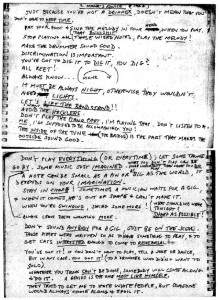solo solo
I’m in Wellington currently working on a solo for Claire Lissaman from Footnote Dance Company. The solo is a response to the work of Phil Dadson – composer, musician, instrument maker, multi-media artist and general all round good guy. I originally intended with reworking some of Phil’s sound pieces (with his blessing) but my computer has died completely. So now the work is being constructed without sound…music TBC.
The solo itself is a structured composition that makes use of choreographed phrases (mostly made by me but some of the material has been made by Claire) and improvisational operations. With Claire I’m working on crafting the place where the phrases meet the improvisational sections. To do this I’m favouring a fluid consistency of dynamics and durational tendencies through both the phrases and the stuff that Claire will author in real time.
I’m working this way for two main reasons. One being that Phil’s work in performance occupies a spectrum of compositional mores from the live open format improvisation to digitally recorded materials. Secondly I’m thumbing my nose at my past tendencies to hold choreography and improvisation apart, problematizing the relationship and sometimes even holding the ‘improv’ banner up as a kind of semi political thing for my work to come from.
In making the solo with and for Claire I’m aware of the obvious..it’s something WE are doing. Duet/solo solo.

